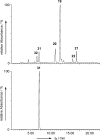Cloning and characterization of the ravidomycin and chrysomycin biosynthetic gene clusters
- PMID: 20140934
- PMCID: PMC2879346
- DOI: 10.1002/cbic.200900673
Cloning and characterization of the ravidomycin and chrysomycin biosynthetic gene clusters
Abstract
The gene clusters responsible for the biosynthesis of two antitumor antibiotics, ravidomycin and chrysomycin, have been cloned from Streptomyces ravidus and Streptomyces albaduncus, respectively. Sequencing of the 33.28 kb DNA region of the cosmid cosRav32 and the 34.65 kb DNA region of cosChry1-1 and cosChryF2 revealed 36 and 35 open reading frames (ORFs), respectively, harboring tandem sets of type II polyketide synthase (PKS) genes, D-ravidosamine and D-virenose biosynthetic genes, post-PKS tailoring genes, regulatory genes, and genes of unknown function. The isolated ravidomycin gene cluster was confirmed to be involved in ravidomycin biosynthesis through the production of a new analogue of ravidomycin along with anticipated pathway intermediates and biosynthetic shunt products upon heterologous expression of the cosmid, cosRav32, in Streptomyces lividans TK24. The identity of the cluster was further verified through cross complementation of gilvocarcin V (GV) mutants. Similarly, the chrysomycin gene cluster was demonstrated to be indirectly involved in chrysomycin biosynthesis through cross-complementation of gilvocarcin mutants deficient in the oxygenases GilOII, GilOIII, and GilOIV with the respective chrysomycin monooxygenase homologues. The ravidomycin glycosyltransferase (RavGT) appears to be able to transfer both amino- and neutral sugars, exemplified through the structurally distinct 6-membered D-ravidosamine and 5-membered D-fucofuranose, to the coumarin-based polyketide derived backbone. These results expand the library of biosynthetic genes involved in the biosyntheses of gilvocarcin class compounds that can be used to generate novel analogues through combinatorial biosynthesis.
Figures





Similar articles
-
The biosynthetic gene cluster for the antitumor drug bleomycin from Streptomyces verticillus ATCC15003 supporting functional interactions between nonribosomal peptide synthetases and a polyketide synthase.Chem Biol. 2000 Aug;7(8):623-42. doi: 10.1016/s1074-5521(00)00011-9. Chem Biol. 2000. PMID: 11048953
-
Cloning and characterization of a polyketide synthase gene from Streptomyces fradiae Tü2717, which carries the genes for biosynthesis of the angucycline antibiotic urdamycin A and a gene probably involved in its oxygenation.J Bacteriol. 1995 Nov;177(21):6126-36. doi: 10.1128/jb.177.21.6126-6136.1995. J Bacteriol. 1995. PMID: 7592377 Free PMC article.
-
Identification of the biosynthetic gene cluster and regulatory cascade for the synergistic antibacterial antibiotics griseoviridin and viridogrisein in Streptomyces griseoviridis.Chembiochem. 2012 Dec 21;13(18):2745-57. doi: 10.1002/cbic.201200584. Epub 2012 Nov 19. Chembiochem. 2012. PMID: 23161816
-
Cloning and characterization of the bleomycin biosynthetic gene cluster from Streptomyces verticillus ATCC15003.J Nat Prod. 2002 Mar;65(3):422-31. doi: 10.1021/np010550q. J Nat Prod. 2002. PMID: 11908996 Review.
-
Comparative analysis of the biosynthetic gene clusters and pathways for three structurally related antitumor antibiotics: bleomycin, tallysomycin, and zorbamycin.J Nat Prod. 2011 Mar 25;74(3):526-36. doi: 10.1021/np1008152. Epub 2011 Jan 6. J Nat Prod. 2011. PMID: 21210656 Free PMC article. Review.
Cited by
-
Cytochromes P450 for natural product biosynthesis in Streptomyces: sequence, structure, and function.Nat Prod Rep. 2017 Aug 30;34(9):1141-1172. doi: 10.1039/c7np00034k. Nat Prod Rep. 2017. PMID: 28758170 Free PMC article. Review.
-
Cyclization of aromatic polyketides from bacteria and fungi.Nat Prod Rep. 2010 Jun;27(6):839-68. doi: 10.1039/b911518h. Epub 2010 Mar 31. Nat Prod Rep. 2010. PMID: 20358042 Free PMC article. Review. No abstract available.
-
Screening for genes coding for putative antitumor compounds, antimicrobial and enzymatic activities from haloalkalitolerant and haloalkaliphilic bacteria strains of Algerian Sahara Soils.Biomed Res Int. 2014;2014:317524. doi: 10.1155/2014/317524. Epub 2014 May 27. Biomed Res Int. 2014. PMID: 24977147 Free PMC article.
-
Engineered biosynthesis of gilvocarcin analogues with altered deoxyhexopyranose moieties.Appl Environ Microbiol. 2011 Jan;77(2):435-41. doi: 10.1128/AEM.01774-10. Epub 2010 Nov 12. Appl Environ Microbiol. 2011. PMID: 21075894 Free PMC article.
-
Characterization of cytochrome P450 monooxygenase CYP154H1 from the thermophilic soil bacterium Thermobifida fusca.Appl Microbiol Biotechnol. 2011 Mar;89(5):1475-85. doi: 10.1007/s00253-010-2965-9. Epub 2010 Nov 6. Appl Microbiol Biotechnol. 2011. PMID: 21057946 Free PMC article.
References
-
- Sehgal SN, Czerkawski H, Kudelski A, Pandev K, Saucier R, Vezina C. J. Antibiot. 1983;35:355. - PubMed
-
- Matson JA, Rose WC, Bush JA, Myllymaki R, Bradner WT, Doyle TW. J. Antibiot. 1989;42:1446. - PubMed
-
- Weiss U, Yoshihira K, Highet RJ, White RJ, Wei TT. J. Antibiot. 1982;35:1194. - PubMed
-
- Yamashita N, Shin-ya K, Furihata K, Hayakawa Y, Seto H. J. Antibiot. 1998;51:1105. - PubMed
-
- Nakajima S, Kojiri K, Suda H, Okanishi M, Antibiot J. 1991;44:1061. - PubMed
Publication types
MeSH terms
Substances
Grants and funding
LinkOut - more resources
Full Text Sources
Molecular Biology Databases
Miscellaneous

